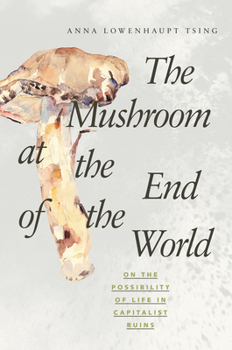 The privately owned mushroom is an offshoot from a communally living underground body, a body forged through the possibilities of latent commons, human and not human. That it is possible to cordon off the mushroom as an asset without taking its underground commons into account is both the ordinary way with privatization and a quite extraordinary outrage, when you stop to think about it. The contrast between private mushrooms and fungi-forming forest traffic might be an emblem for commoditization more generally: the continual, never-finished cutting off of entanglement.
The privately owned mushroom is an offshoot from a communally living underground body, a body forged through the possibilities of latent commons, human and not human. That it is possible to cordon off the mushroom as an asset without taking its underground commons into account is both the ordinary way with privatization and a quite extraordinary outrage, when you stop to think about it. The contrast between private mushrooms and fungi-forming forest traffic might be an emblem for commoditization more generally: the continual, never-finished cutting off of entanglement.
Anna Lowenhaupt Tsing's The Mushroom at the End of the World is a deep dive into the informal economy that produces the matsutake mushroom. Prized by consumers, especially those in Japan and Eastern Asia, the matsutake grows in forests from Oregon to Yunnan to Finland. Where it is picked, it is picked by loose "assemblages" of people operating on the margins of official society. In America, that often means Southeast Asian immigrants, Hmong and Lao, among others, as well as white survivalist types who embrace the notion that mushroom hunting offers a kind of freedom from the demands of normative society. Tsing's thesis, as far as I can tell, seems to be that this is a kind of economy that is not capitalist, that emerges from a kind of commons, but that these non-capitalist modes of economic activity are quickly and summarily subsumed by the capitalist economy. I don't know about that--but maybe I mean that literally, because the economic angle here isn't exactly my forte.
In general, I expected the book to be more about mushrooms, and less about economic and social theory. But I did enjoy how Tsing manages to bring together many modes: straight reporting about the matsutake pickers, of course, and economic theory, but also ecology and social history. In the growth of the mushroom, which relies on mutualistic assemblages so vast it's hard to isolate the fungus into specific, isolated species, she finds a powerful metaphor for the commons. As a result it's hard to say what kind of book this is, though I think a general reader might find its more theory-laden sections difficult.
One thing that struck me: The matsutake, as Tsing describes it, actually thrives best in the most ecologically ruined forests. In America, that means in forests of opportune lodgepole pines that emerge in the wake of clearcut ponderosas. This points to something that Tsing describes as "salvage," that I'm not sure I quite understood, but which has something to do with the way that the ruins of capitalist activity are reinscribed into informal economies. In that sense, there's an interesting kind of circularity to the economy that Tsing describes: it thrives in the wake of capitalist ruin and excess, transformed into an informal economy that is then reinscribed into the formal economy by buyers and wholesalers.

No comments:
Post a Comment